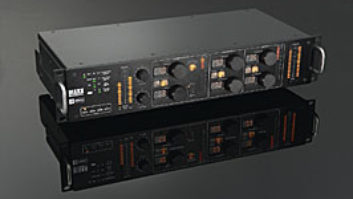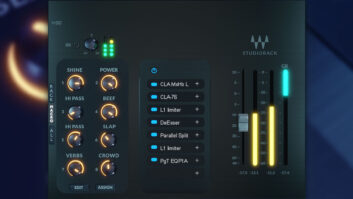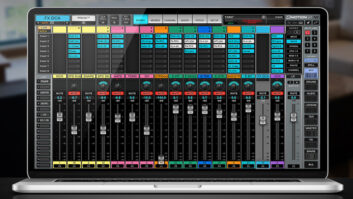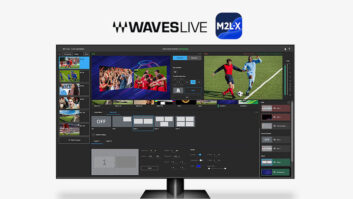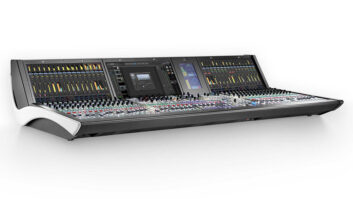Plug-ins from Waves Native Power Pack have resided in both my Mac and Windows computers since 1997, and I would be in a world of hurt (on a pro audio level) without them. Being both a longtime Waves user and an advocate of better audio on the Web, I jumped at the chance to review MaxxStream.
What is MaxxStream? To begin with, MaxxStream is an industrial-strength, rackmounted PC, specifically designed as an all-in-one Internet audio processing/encoding solution for the broadcast industry. Combining the operating stability of the Windows NT 2000 environments, with a proprietary Waves soundcard (sporting onboard DSP) and Waves audio processing software, MaxxStream could easily be mistaken for a Waves DAW. Its only purpose in life, however, is to receive a live audio stream, premaster it (on-the-fly) using Waves software for encoding, encode the target audio live in the RealMedia, Windows Media, MP3 or Quicktime audio formats, and deliver it directly to a streaming server for Internet distribution. Did I mention this was all in real time?
CONFIGURATIONS
MaxxStream is available in two basic configurations, the M100 and the M200. (The MaxxStream PCI card is included in both the M100 and M200, and can also be purchased separately for use in any Windows NT or 2000 computer.) The entry-level MaxxStream M100 is a single-rackspace PC with a 466MHz Celeron processor, one MaxxStream DSP card (to handle the I/O and DSP chores), and Waves processors and encoding software. The standard M200 comes with a little more horsepower under the hood (specifically a Pentium III 800MHz CPU), and can be configured to work with as many as four DSP cards. An M200 with four DSP cards installed can process and deliver eight or more separate audio streams simultaneously, dependent on CPU.
THE COMPONENTS
The Wave Rack (Fig. 1) is a chain of Waves processors optimized to enhance the target audio stream for playback over the Internet. A custom Rack can be configured from scratch or there are a variety of preset Wave Racks that will meet most, if not all, broadcast-encoding needs. Audio professionals who have used the Waves NPP and Gold Bundle plug-ins will be familiar with most of the MaxxStream software processors, specifically the Q10, AudioTrack, C1, C4-24-bit, L1, S1, De-Esser and MaxxBass. Any or all of these processors can reside in a Wave Rack.
The MaxxStream PCI card offers both analog and digital I/Os, including balanced XLR, unbalanced RCA, AES/EBU and S/PDIF. The DSP on the MaxxStream card is handled by a Motorola 56301. The obvious advantage of having a separate DSP card is that the host CPU is free to run the OS and encoding software.
MaxxStream is a Windows NT 4.0/2000-compatible system. Unlike the consumer versions of the Windows OS, Windows NT 4.0/2000 Professional is just about bulletproof in regards to stability and ability to stay up and running 24/7. Also, by using the industrial-strength version of Windows, a MaxxStream system can run multiple soundcards, and has the capacity to process and encode multiple audio streams simultaneously.
IN USE
Once MaxxStream is booted and running, it is simply a matter of choosing the proper Wave Rack preset and, at the most, making a minor adjustment to the input and output levels in the audio chain. Loading a Wave Rack is as easy as selecting the encode quality (low, medium or high) and choosing a preset that most closely matches the content of the broadcast stream (classical, rock, speech, etc.). Each software processor (or plug-in, if you like) can be opened and edited by clicking on its location in the Wave Rack (see Fig. 2). It is, of course, a necessary step in the process to launch the encoding software (RealProducer Plus or Windows Media Encoder) and set the attributes to match the targeted streaming audience. Both RealProducer Plus and the Windows Media Encoder have rudimentary input meters that will get you into the ballpark with regards to whether your processed audio signal is too low or too high.
One minor inconvenience that I ran into with the review unit (M100 with NT 4.0) was the lack of a mixer utility for the MaxxStream soundcard. Both RealProducer Plus and the Windows Media Encoder rely on this utility for volume control within their applications. Without this utility, the volume levels for the encoding software can only be controlled from the Wave Rack. Once the user is aware of this, it should not be a problem.
MONITORING AUDIO
In my review unit, I was not able to effectively monitor the audio signal (post-processing) through the analog or digital outputs in the MaxxStream soundcard. This has more to do with the way the encoding software works than with the MaxxStream system itself, as it’s not possible to hear the results of the encoded stream without launching either the RealPlayer or the Windows Media Player and listening to the stream playback through a consumer soundcard. The MaxxStream unit does have a SoundBlaster consumer audio card installed, and thanks to the multitasking nature of Windows NT, it is possible to monitor the live stream (post-processing and encoding) this way.
REAL PRODUCER PLUS 8.5, WINDOWS MEDIA ENCODER
One of the available MaxxStream options is RealProducer Plus 8.5 from RealNetworks. A distinct advantage to using RealProducer Plus to encode a live audio stream is the SureStream option. With SureStream, a single incoming audio stream can be encoded into the streaming RealMedia format and delivered to the RealServer in as many as eight different target bit rates. Also, the audio codec in 8.5 sounds considerably better than in previous versions.
Unlike the RealProducer Plus, the Windows Media Encoder installed on MaxxStream only allows the user to encode the audio stream at a single bit rate. This is due to limitations in the “basic” Windows Media encoder that ships with MaxxStream. MaxxStream does, however, allow the user to encode and deliver RealMedia and Windows Media content simultaneously using one DSP card.
IN CLOSING
I will admit that I initially had some problems adjusting to the quirks of Windows NT 4.0 (vs. 98), and also had to get over a few preconceived notions as to what exactly MaxxStream was and was not — I kept thinking it was a DAW. MaxxStream is designed to give the emerging Internet broadcast industry an all-in-one audio processing/encoding solution that can stand up to the rigors of running 24/7 without crashing. By integrating its industry-standard Waves processors with one or more DSP cards, and using an industrial-strength rackmount Windows PC, Waves has created a unique and powerful tool. The Web audio/Webcasting industry has long been plagued by poor sound quality, and by introducing MaxxStream into the audio chain of events, any Internet broadcast will sound a whole lot better.
Note: When I started this review, Windows NT 4.0 was the operating system being shipped with MaxxStream, but Windows 2000 Professional (originally dubbed NT 5.0) is now the current OS. Also, the C4 processor/plug-in had not been installed in my review unit, but is now shipping with all MaxxStream systems. For the record, I’m using the C4 in Pro Tools, and it rocks.
Waves, 6716 Central Ave, Suite 8, Knoxville, TN 37912; 423/689-5395; fax 423/688-4260; www.waves.com.
Ron Simpson is a freelance writer and Web audio technologist based in Phoenix, Ariz.
To EQ or Not To EQ
When encoding an audio file (live stream or archived) to a compressed audio format such as RealAudio or Windows Media, you will end up throwing away 90% or more of the original program material. Even with the most up-to-date audio codec, the end result will pale in sonic comparison to the original source material. By anticipating the (post-encoding) signal loss and selectively boosting the EQ (pre-encoding), much of the damage can be averted, resulting in an encoded audio stream that is truer to the original source than otherwise possible.
The multiple processors in a Wave Rack take this basic concept of pre-encoding manipulation of an audio file to another level altogether. The only danger I can foresee is over-processing an audio file. Still, too many options are way better than too few.
— Ron Simpson
